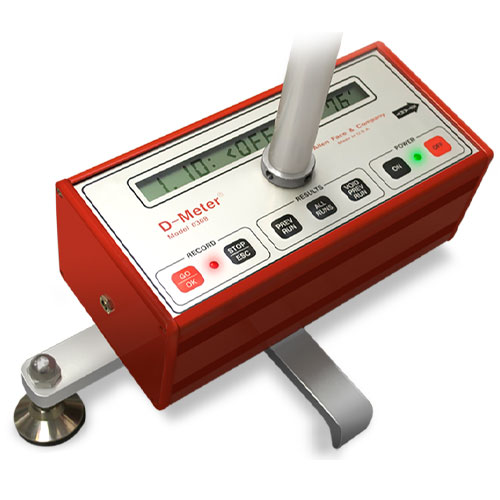D-Meter® Floor Profiler and the Dipstick ®
both invented by Allen Face!

Dipstick® was invented in 1982,
and sells for $9950
In 1991, Allen Face left Face Construction Technologies. He started his own firms, improved upon his previous efforts, and re-invented the industry standard that he defined:
D-Meter® was invented in 2003,
and sells for $8995
Allen Face is the author of the F-Number System, inventor of the Dipstick®, and one of the world’s leading authorities on the design, construction, and quality control of concrete floor slabs.
Since leaving Face Construction Technologies Inc in 1991, Allen Face moved on to form his own ventures. Since that time, he invented the D-Meter Walking Floor Profiler and the F-Meter Hi-Speed Rolling Floor Profiler.
Please see the following official memorandums issued regarding this situation:
OFFICIAL MEMORANDUM
TO: Testing Equipment Buyers
FR: Profiler Division Mgr.
DT: 2-24-09
RE: Floor Profiler Market
I am distributing this memorandum to clear up some confusion that persists regarding the background and status of the floor profilers manufactured by Face Construction Technologies Inc. of Norfolk, VA and Allen Face and Company, LLC of Wilmington, NC.
For the record, in addition to creating both the Fmin and FF/FL floor profile numbering systems, Allen Face is the inventor of the Face Floor Profileograph (1975), the Dipstick Floor Profiler (1982) , the Self-Recording Dipstick (1986), the F-Meter Rolling Floor Profiler (1993), the Downloading F-Meter (2003), and the D-Meter Walking Profiler (2003). His name alone is on all the pertinent patents.
In 1991, owing to fundamental differences in management philosophy, Allen was compelled to sell his 50% interest in Face Construction Technologies (including all the patents) to his father, Sam, and his brother, Brad. Having been effectively forced out, and unbound by any non-compete agreement, in the next 2 years Allen started two new companies in competition with FCT: Allen Face & Associates (to provide floor design, construction, quality control, and expert witness consulting services) and Allen Face & Company (to manufacture the F-Meter – his next-generation, high-speed, rolling profiler).
Sam Face died in 2001, leaving Face Construction Technologies to Brad. FCT still only manufactures the Dipstick, the basics of which (i.e. separate computer, proprietary software, replaceable batteries) have remained essentially unchanged since 1986. Allen Face & Company manufacturers the fully integrated D-Meter – i.e. a “modernized Dipstick” – and the equally self-contained and easy-to-use F-Meter. All these devices are fully ASTM E1155 compliant
I have observed that many people are surprised to learn about the existence of an Allen Face-designed alternative to the Dipstick. And for those looking to acquire a new unit, the D-Meter’s lower price tag and much superior performance (faster set-up, no lost data, no false readings, no batteries to change, Excel compatibility, etc.) make the surprise all the more pleasant.
I hope the information below will help to clarify the state of the present floor profiler market, and would welcome any questions that anyone might have.
“WALKING” FLOOR PROFILER UPDATE
Since Allen Face’s invention of the original Dipstick back in 1983, it has naturally enjoyed a special status as the “granddaddy” of all profilers. The original Dipstick was, in fact, just a walking inclinometer fitted on top with dual numeric displays to show the signed elevation differences between its two feet. The readings were either recorded manually (by an assistant writing on a data sheet) or verbally (by the operator speaking into a hand-held tape recorder). These data then had to be keyed individually into a TI-55 programmable calculator to compute the results.
To automate both the data collection and calculations, in 1986 Allen created the Auto-Recording Dipstick. By coupling an external “pocket computer” (originally a Radio Shack TRS 80) with the manual instrument, he was able to make the unit decide for itself when to record each reading, and then store the resulting data sequence as a “run record” in the computer’s memory. After all desired runs were recorded, the computer would then be detached and placed into its companion Printer/Cassette Interface both to print out the results (on a 2.5” wide paper roll) and archive the data (on a cassette tape).
While the Auto-Recording Dipstick was a vast improvement over the original manual device, it did suffer from a number of persistent problems:
Catastrophic Zeroing Errors : The Dipstick must be zeroed every time it is turned on. If the operator skips this zeroing step, or if he/she performs it incorrectly, then the reported FF values will be depressed significantly. Since under-reporting of FF results – even on a single day’s pour – can be catastrophic for everyone (and especially the lab that issues the false report), the Dipstick’s inherent susceptibility to zeroing errors is its most serious design flaw. In contrast, since the D-Meter never needs zeroing. it is entirely immune to this type of catastrophic operator error. In fact, if the operator simply can be relied upon to walk the unit along the proper test lines, then the results produced by the D-Meter become immune to any type of operator error.
Occasional Loss of Data : If the computer’s batteries failed at any time, or its program ever got “hung up”, all data in memory would be lost. If the runs had been archived on cassette, then the data would have to be re-loaded. But if no tape record yet existed, then the consequences were catastrophic, since the only recourse was to re-do the entire test.
Recurring Obsolescence : Owing to the rapid evolution of processors, the external computers would routinely become obsolete every 2 or 3 years and be discontinued. The system would then have to be re-engineered around a new replacement computer (the retro-fitting of which would be sold as an “upgrade”).
Proprietary Software : Since the data collection and analysis software had to be tailored to each new replacement computer, rather than building the system around a universal package like Excel, the software had to remain proprietary.
Occasional False Readings: The protocol governing the data capture was imperfect, and a reading would occasionally be recorded while the unit was being swung to the next reading point. This error inverts (and compromises) the remainder of the run.
Mechanical & Operational Complexity: Separating the computer and sensing hardware multiplied the required number of external connections and power supplies, and essentially fractionated the entire system. This led to all manner of difficulties, not the least of which were the lengthy and cumbersome set-up procedure, the permanent need for special interfacing software, an inherent susceptibility to FF errors (in the event of a zero shift), and a general “cobbled-together” character.
When Allen left the Face Companies in 1991 to form his own consulting firm, he left ownership of the patents and Dipstick behind, and indeed, the old company still manufactures the 1986 unit (with cosmetic changes) in Norfolk VA. Except for the occasional computer “upgrade” or cosmetic alteration, in the past 18 years the instrument has remained essentially unchanged, and many of the above problems persist.
In 2003, the patents having lapsed, Allen re-visited the design of the Dipstick. Starting from scratch and incorporating all that 30 years in electronic floor profiler design and manufacture had taught him, Allen created the D-Meter – the fastest, most accurate, least expensive, most user friendly, ASTM E1155 “walking” profiler available in the world today. The D-Meter, of course, solves all of the problems still being suffered to this day with the original machine:
The Data Cannot Be Lost: If the power pack dies, if the program locks up, even if the D-Meter is physically damaged, the data will survive and remain recoverable.
The Unit Cannot Become Obsolete: Since the computer is inside the D-Meter, any software changes will be forever backwards compatible. Note also that all available software upgrades are installed free-of-charge as part of the annual re-calibration.
The Software Is All Excel Based: The D-Meter’s downloading program puts all the runs, graphs, and statistical results into a standard format Excel workbook. Once the download is complete, the operator is left working in Excel.
The Unit Cannot Record A False Reading: The D-Meter employs a unique new triggering protocol that immunizes the unit against the ambiguities that lead to false readings.
The Unit Is Mechanically & Operationally Simple: The D-Meter consists of a handle and block body standing on 2 legs. (Imagine a Dipstick without the computer and umbilical wires.) There is no separate computer to fool with. There are no batteries to change (the unit is powered by an internal re-chargeable Li-Ion battery pack). There are just 7 buttons on the control pad: Power On, Power Off, Record Go, Record Stop, Previous Run Results, Summary Results, and Void Previous Run. All individual run and summary results may be displayed at any time on the D-Meter’s 20-character LCD screen, and everything downloads via USB to a PC Excel workbook with a single mouse click.
So when the time comes to upgrade an existing Dipstick, or to purchase a new walking floor profiler, please consider trading up to the D-Meter. It’s simply a much better unit.





